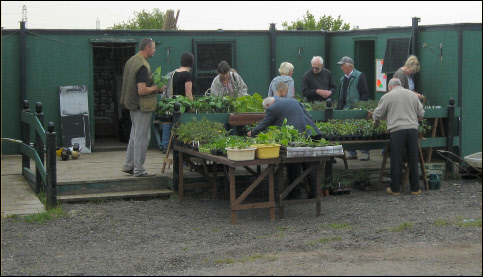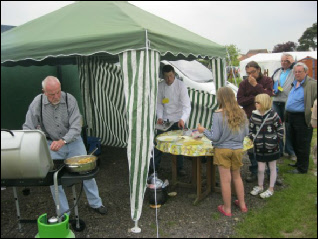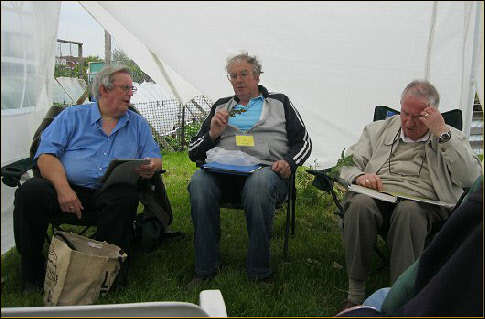

Make a point of visiting us weekly! Tell a friend about us.
Return to Allotment Association CONTENTS
Rochford Allotment Association
Past Events:Plant & Produce Sale & Gardeners’ Question Time: 20th May 2012
This was not just a day of plants, this was also a day of Barbecued food and then a Gardener’s Question Time.
A grey morning gave way to patchy sunshine and at kick-off time of 9.30am tables were full of plants and a steady flow of people arrived, eager to stock up their gardens or plots at the beginning of the planting out season. Early on a team had erected a marquee for the Gardeners Question time after lunch, and a smaller pergola was put up to cater for the lunch-time barbecue. Sharpening Solutions provided a knife & shear sharpening service throughout the morning.
A grey morning gave way to patchy sunshine and at kick-


Plants and produce are plentiful
It’s lunchtime and the barbecue is well under way

(To the left) Chairing the ‘Gardeners Question Time’, committee member Paul Nice discusses a weed variety with the two judges from the Essex Guild of Horticulture, Robert Wiseman (Left) and Mike Taylor (Right) before the question time started.
Below we have taken just two of the questions asked, to give a sense of the breadth of allotment keeping
The first question shows us the goals of allotment keeping, if you want to aim for something more than basic growing.
Question: When you are judging a plot, what are you looking for? Is it flowers, fruit and veg, or is it weed-free environment or all of the above?
Answer: The basic criteria for judging a plot is laid down by the RHS saying that they expect certain things. There is a points scale. The RHS scale has 350 points and I’ve scaled that down to judge out of a 100 because it makes counting a lot easier. A good allotment plot should allow you to have marks for flowers, fruit and vegetables and I think that is about 20% each of the marks. Good cultivation also has a proportion of marks. The quality of your compost heaps, outbuildings and other facilities also comes into the equation, likewise ingenuity overcoming local problems. Somebody who has taken over a new plot and has put down a fabric mesh to kill off weeds would achieve marks for that. The overall design of the plot comes into it . There are actually twelve criteria and I have to consider all of them. If you have no flowers on the plot, you have already automatically lost maybe 15% of the marks because an allotment plot should grow flowers, fruit and veg. Plots are assessed individually and you really need to see the Parish Council’s criteria, for Parishes vary in their requirements. We also take note of the contents of greenhouses and poly-tunnels.... Continuity is important ... If someone has a full size plot but they are only cultivating four small beds in it, and they use the rest as somewhere to sit out, they might get a little something for novelty and innovation but if half the space is not cultivated, it might be perfectly mowed but is that what allotments are really all about?
A later question considered beginners, perhaps those just starting out with an allotment.
Question: Suppose we have a young couple just starting out with an allotment what would you advise them to grow to start off?
Answer: Vegetables: Potatoes are an easy crop as are runner beans. Those are the two I would start anybody on because they are going to get success, with both of those. Courgettes are another one. Two courgette plants will meet the needs of most families. Marrow is relatively easy. Salads can prove difficult because pest control can become a problem. The natural mistake a beginner would make is to grow a whole row of lettuce at a time. Instead sow half a dozen seeds every week or fortnight. A couple of other easy ones are onions because you can buy them in sets, and shallots. I do encourage beginners with loose leaf salad leaves because you can cut those continuously. Flowers - easy flowers are sweet peas and if you plant them near your runner beans it attracts more insects and gives you better pollination. Fruit: red currents are relatively easy and gooseberries are extremely easy but, a word of advice, never grow gooseberry as a bush, grow it as a single cordon (pruned to grow as a single stem)and then you can pick them without ripping your fingers to shreds. Rhubarb gives you a very good crop after a couple of years, and so will strawberries. If you grow raspberries, get three or four canes of several different varieties each, for the simple reason that, for example, I start picking raspberries end of June, beginning of July, and last year I picked enough to out in a raspberry and apple pie in the beginning of November.
Question: When you are judging a plot, what are you looking for? Is it flowers, fruit and veg, or is it weed-
A later question considered beginners, perhaps those just starting out with an allotment.
Question: Suppose we have a young couple just starting out with an allotment what would you advise them to grow to start off?
Answer: Vegetables: Potatoes are an easy crop as are runner beans. Those are the two I would start anybody on because they are going to get success, with both of those. Courgettes are another one. Two courgette plants will meet the needs of most families. Marrow is relatively easy. Salads can prove difficult because pest control can become a problem. The natural mistake a beginner would make is to grow a whole row of lettuce at a time. Instead sow half a dozen seeds every week or fortnight. A couple of other easy ones are onions because you can buy them in sets, and shallots. I do encourage beginners with loose leaf salad leaves because you can cut those continuously. Flowers -